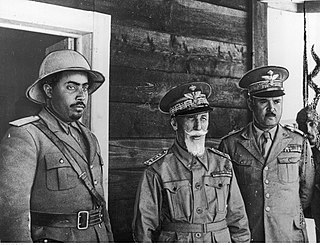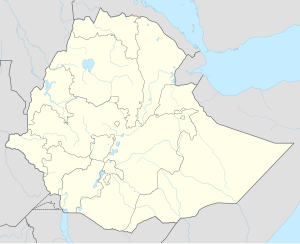
The Battle of Adwa was the climactic battle of the First Italo-Ethiopian War. The Ethiopian forces defeated the Italian invading force on Sunday 1 March 1896, near the town of Adwa. The decisive victory thwarted the campaign of the Kingdom of Italy to expand its colonial empire in the Horn of Africa. By the end of the 19th century, European powers had carved up almost all of Africa after the Berlin Conference; only Ethiopia and Liberia still maintained their independence. Adwa became a preeminent symbol of pan-Africanism and secured Ethiopian sovereignty until the Second Italo-Ethiopian War forty years later.

Adwa is a town and separate woreda in Tigray Region, Ethiopia. It is best known as the community closest to the site of the 1896 Battle of Adwa, in which Ethiopian soldiers defeated Italian troops, thus being one of the few African nations to thwart European colonialism. Located in the Mehakelegnaw Zone of the Tigray Region, Adwa has a longitude and latitude of 14°10′N38°54′E, and an elevation of 1907 meters. Adwa is surrounded by Adwa woreda.

Amhara Region is a regional state in northern Ethiopia, and the homeland of the Amhara people. Its capital is Bahir Dar. Amhara is the site of the largest inland body of water in Ethiopia, Lake Tana, and of Semien Mountains National Park. Amhara is bordered by the state of Sudan to the west and northwest, and by other regions of Ethiopia: Tigray to the north, Afar to the east, Benishangul-Gumuz to the west and southwest, and Oromia to the south.
Egwale Seyon or Gwalu (ጓሉ) was nəgusä nägäst of Ethiopia, and a member of the Solomonic dynasty. He was the son of Hezqeyas.

Adigrat is a city and separate woreda in the Tigray Regional State of Ethiopia. It is located in the Misraqawi Zone at longitude and latitude 14°16′N39°27′E, with an elevation of 2,457 metres (8,061 ft) above sea level and below a high ridge to the west. Adigrat is the last important Ethiopian city south of the border with Eritrea, and is considered to be a strategically important gateway to Eritrea and the Red Sea. Adigrat was part of Ganta Afeshum woreda before a separate woreda was created for the city. Currently, Adigrat serves as the capital of the Eastern Tigray zone.

Debre Tabor, home of the Amhara People, is a town and a woreda in north-central Ethiopia. Located in the Debub Gondar Zone of the Amhara Region of Ethiopia, about 100 kilometers southeast of Gondar and 50 kilometers east of Lake Tana, this historic town has a latitude and longitude of 11°51′N38°1′E with an elevation of 2,706 metres (8,878 ft) above sea level. The presence of at least 48 springs in the area contributed to the development of Debre Tabor.

sabagadis is wrong. Subagadis is right.

RasMengesha Yohannes was governor of Tigray and a son of atse Yohannes IV. His mother was Welette Tekle Haymanot wife of dejazmach Gugsa Mercha. Ras Araya Selassie Yohannes was his older half brother. Prior to the Battle of Metemma, Mengesha Yohannes was considered to be a nephew of Emperor Yohannes IV. During the battle, the Emperor was mortally wounded and it was on his deathbed that Mengesha Yohannes was acknowledged as his "natural" son and designated as his heir. This created something of a succession problem.

Abiy Addi is a town in central Tigray, Ethiopia. It has a latitude and longitude of 13°37′23″N39°00′06″E with an elevation ranging from 1917 to 2275 meters above sea level. Abiy Addi is at the southeastern edge of the Kola Tembien woreda, of which it is the capital.
Meket is one of the woredas in the Amhara Region of Ethiopia. It is named after a former district located approximately in this area. Located on the western side of the Semien Wollo Zone, Meket is bordered on the south by Wadla and Dawunt, on the west by the Debub Gondar Zone, on the northwest by Bugna, on the north by Lasta, on the northeast by Gidan, and on the east by Guba Lafto. The administrative center of Meket is Filakit Gereger; other settlements include Agrit, Arbit, Gashena and Debre Zebit.
Enderta or Inderta is a former historical province of Ethiopia; it is located in the eastern edge of the Tigray highlands. Enderta is bordered on the west by Tembien, on the south and southwest by Lasta and Wag, on the east by denkel, and on the north by Agame and Adwa. Mekelle was formerly the capital of the province. Enderta's local administration of Denkel/Afar up to the edges of Aseb under its jurisdiction seems to have been highly, interlinked with the operation of the salt trade and its taxation system; the entire tasks of salt caravan organization being the responsibility of the bäalgada, title assumed by the governor of Endärta, since at least the Medieval period (c.1270-1527)

Seyoum Mengesha KBE was an army commander and a member of the royal family of the Ethiopian Empire.

Haile Selassie Gugsa (1907–1985) was an army commander and a member of the Imperial family of the Ethiopian Empire from Tigray.
The Battle of Anchem was a battle fought between two factions of the Royal family in the Ethiopian Empire. The battle was fought to determine who would rule the empire, Empress Zewditu or King (Negus) Tafari Makonnen.
The Checheho River is a small river located in north-central Ethiopia. Part of the watershed of the Abay River, it rises to the east of Debre Zebit to flow south to join the Bashilo River. Its major tributary is the Zhit'a, which enters the Checheho on the left side.

Nefas Mewcha is a town in northern Ethiopia. Located in the Debub Gondar Zone of the Amhara Region, this town has a latitude and longitude of 11°44′N38°28′E and an elevation of 3150 meters above sea level. It is the administrative center of Lay Gayint woreda.
Gugsa Wale's rebellion of 1930 was a rebellion raised by Ras Gugsa Wale and by supporters of Empress Zewditu to rid her of the Crown Prince and heir apparent, Negus Tafari Makonnen. With Tafari gone, Zewditu would be the sole claimant to succession as the ruler of the Ethiopian Empire. As the husband of Empress Zewditu, Gugsa Wale expected to become Emperor.

Woyane rebellion was an uprising in Tigray Province, Ethiopia against the centralization process from the government of Emperor Haile Selassie which took place in May–November 1943. The rebels called themselves the Woyane, a name borrowed from a game played locally between competing groups of young men from different villages, which connoted a spirit of resistance and unity. After nearly succeeding in overrunning the whole province, the rebels were defeated with the support of aircraft from the United Kingdom's Royal Air Force. Out of all the rebellions that engulfed Ethiopia, this was the most serious internal threat that Haile Selassie faced.

The Debre Abbay massacre was a mass extrajudicial killing that took place in Debre Abbay in the Tigray Region of Ethiopia during the Tigray War, around 5–6 January 2021. Part of the massacre was filmed in the village of May Harmaz that belongs to tabiya Debre Abbay, woreda Tsimbla, Northwestern zone of Tigray. Later on, the killing spree affected also other villages of the tabiya.

The Debre Genet massacre was a mass extrajudicial killing that took place in Debre Genet in the Tigray Region of Ethiopia during the Tigray War, on 27 April 2021. Debre Genet is a village in woreda Adet, Central zone of Tigray.














